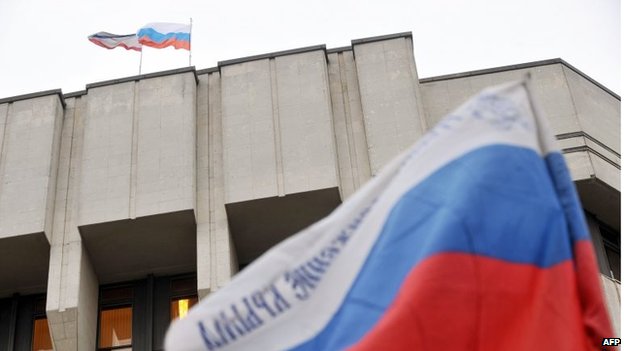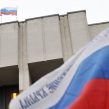
Russia Retakes Crimea: Political Implications
Publication: Eurasia Daily Monitor Volume: 11 Issue: 54
By:

Russia’s annexation of Crimea from Ukraine is now an accomplished goal in its own right. But it is also an intermediate goal, part of a broader agenda to threaten Ukraine with fragmentation or decomposition, unless Ukraine reorients toward Russia. In turn, Ukraine’s reorientation or its unraveling could dramatically overturn the power balance in Central Europe, exposing that entire region to direct pressures from a resurgent Russia.
Moscow’s proposals to reorganize the Ukrainian state, as notified by Russian Foreign Minister Sergei Lavrov to US Secretary of State John Kerry (Interfax, March 14, 15), reveal Russia’s goal to arbitrate Ukraine’s internal and external policies by manipulating centrifugal trends in that country. The experience with Viktor Yanukovych’s presidency has convinced Moscow that no pro-Russia force can any longer win and hold power in Kyiv and deliver serious concessions to Russia. Instead, Moscow proposes to bring friendly forces to power in Ukraine’s eastern and southern regions and empower those regions in a new constitution, so as to paralyze and frustrate pro-Western initiatives from the central government in Kyiv.
Crimea’s March 16 plebiscite is advertised to inspire plebiscites in Ukraine’s eastern and southern regions, albeit not for outright secession, but for federalization (Crimea’s referendum included a federal/confederal option). Russian officials and televised propaganda encourage oblast-level plebiscites in Ukraine’s east and south for “federalism.” Moscow undoubtedly plans to promote these proposals under the guise of democratic de-centralization of power, in discussions planned to be held on Ukraine’s new constitution. Moscow apparently seeks to enlist support from the United States for Ukraine’s federalization and present this jointly to Ukraine.
Annexing the Crimean peninsula, Moscow is also transferring approximately 1 million Crimean Russian voters, from Ukraine’s electoral system to Russia’s. But this does not imply a net loss of Russian political influence in Ukraine. Clearly, the Crimean Russian million was no longer enough to tip the balance for Russia in Ukraine’s country-wide elections. Russia’s new, more far-reaching strategy focuses on de-constructing Ukraine from the mainland (see above).
Ethnic Russians form slightly more than one half of Crimea’s total population of 2.2 million. The military-political putsch, carried out by Russian authorities on the peninsula (February 23–March 18), and intense propaganda from Moscow mobilized support for the “return of Crimea to Russia.”
Mass support was, however, by no means foreordained, nor an organic development. Russian national irredentism was a marginal phenomenon in Crimea during the last 20 years. The Crimean branch of Ukraine’s Party of Regions (PoR) firmly controlled the political processes. Loyal to two power centers in mainland Ukraine, namely Kyiv and Donetsk, the PoR held an overwhelming majority of the seats in the Crimean autonomy’s parliament and government. Corruption within the Crimean PoR was proverbial. Perversely, it contributed (as elsewhere in Ukraine) to holding the fragile political system together on the basis of clan interests, in the absence of other sources of legitimacy.
The nationalist Party of Russian Unity had received merely 4 percent of the votes in Crimea’s last parliamentary elections. It operated as a marginal opposition group in Crimea, and was practically unknown to Moscow’s policy makers, until Moscow decided in the third week of February to seize Crimea from Ukraine. Senior Russian politicians descending on Crimea identified the Party of Russian Unity as the main political agent for the military-led coup (see EDM, February 28).
The Crimean PoR hesitated initially, but folded and joined the Russia bandwagon after the regime had changed in Kyiv. This party’s future looks uncertain in Crimea. There (as in Ukraine’s south-eastern regions), Moscow seems increasingly to favor Russian neo-nationalists who seek to supplant the traditional local PoR nomenklatura.
Crimea’s new political leaders, Sergey Aksyonov and Vladimir Konstantinov, represent that type of politician that Moscow now favors. Moreover, they fit within the context of trans-border, Greater-Russia nationalism that the Kremlin currently promotes. Aksyonov and Konstantinov are Russians from Moldova (from Balti in Moldova’s north and from Slobozia in Tansnistria, respectively); and some of their statements appeal to neighboring Ukrainian oblasts and Transnistria to join Crimea in returning together to the “Russian world.”
According to Aksyonov, Crimea does not need to provide for the Ukrainian language to be used in public life, since “people here practically do not speak it; just 1 percent of Crimea’s population uses the Ukrainian language” (Interfax, March 10). Although grossly inaccurate, Aksyonov’s statement unwittingly contradicts the Kremlin’s line that Crimea’s Russians need protection from Ukrainian nationalism. In fact, the Ukrainian element, comprising more than a quarter of Crimea’s population, is in dire lack of Ukrainian-language schools.
Russian President Vladimir Putin, in welcoming Crimea into the Russian Federation on March 18, declared that Crimea must confer official status on the Ukrainian language, alongside Russian and Crimean Tatar (Interfax, March 18). The accession treaty, signed on the same day in Moscow, defines Crimea as a multi-ethnic republic with three official languages (see above), but this is purely symbolic. For their part, Tatars regard their prospects in a Crimea under Russian rule as bleak (see EDM, February 28).
The “multi-ethnic, trilingual” Crimea seems set to become like the “multi-ethnic, trilingual” Transnistria, an experiment in russification of non-Russians and the forging of a Greater-Russia identity.




